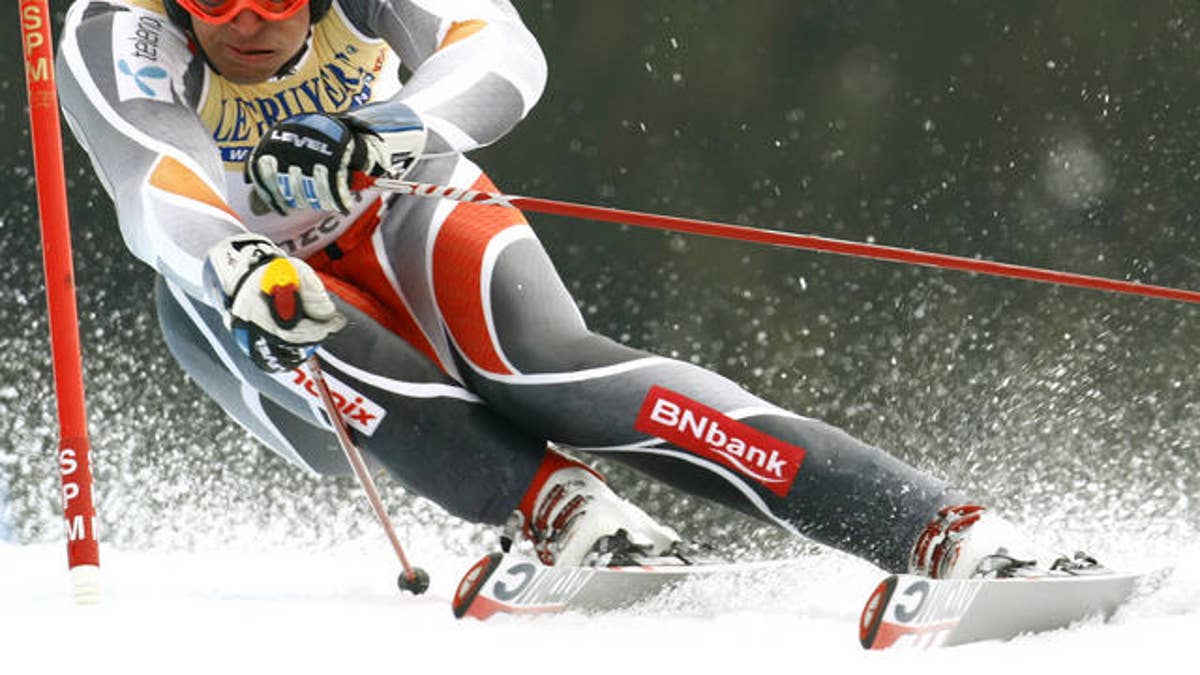
Aksel Lund Svindal, of Norway, speeds down the course on his way to winning an Alpine Ski, Men's Giant Slalom, at the World Cup finals in Lenzerheide, Switzerland, Saturday, March 17, 2007. (AP Photo/Alessandro Trovati) (AP)
At first glance, skiing isn’t for everyone. You need to embrace the cold, prove your athletic instinct – agility, endurance, strength, power and flexibility – and definitely, expect to fall big time if you’re a newbie.
Don’t think because you squat heavily or run 10 miles easily that you’ll be ready for the mountains. Cynthia Gonzalez, DPT, OCS, ATC, CSCS, from Orthopedic Rehabilitation Specialists, says the “person who has never exercised will probably get tired faster and have less chance to hurt themselves. For the fit person, the skills are definitely not transferable, plus with skiing you have high speed and high impact injuries from not controlling yourself.”
With skiing as with any other sports, the concept of specificity applies. Each sports imposes specific neuro-muscular and energy demands so “the concept of speed, strength or strength must be applied to the context of the specific movement patterns and specific metabolic and physiological requirements of the activity,” says authors William D. Mc Ardle, Frank and Victor Katch, Exercise Physiology: Energy, Nutrition and Human Performance.
Know the Risks
Gonzalez points out that the most common injuries from skiing are anterior cruciate ligament tears of the knee (ACL), tib/fib fractures and skiers thumb. And, those who come from places like South Florida, where people are used to zero elevation, also might experience altitude sickness.
Start by strengthening the core and start doing planks. Work on the specific skills that you’ll need to stay on the poles. “I advise to do cardio for general fitness and endurance while the only strengthening exercise I would add is isometric squats either against the wall or free standing. Most trails are 1- 10 minutes in length without rests, so holding the squat as long as possible is best,” says Gonzalez.
Balance training drills are advised and should be initiated on level ground before progressing to unsteady surfaces. Christopher Johnson, MPT, MCMT, ITCA, recommends performing single leg balance drills 3-5 times, 1 minute holds per side. It is also helpful to perform lower extremity strengthening exercises. With proper technique, exercises such as deadlifts, squats, and step ups are also helpful. It should be emphasized that the eccentric component (the lowering phase) of these exercises is important as skiing challenges eccentric control. Moving along, counter jumps on to a platform (3 sets of 10) are also important and are a form of plyometric training that is important to expose the body to prior to skiing.” The technique on these exercises is really important, so look to a fitness professional if you need guidance.
As for motion sickness, experts agree that generally, it’ll take several days to adapt depending on the elevation. Initially, hyperventilation and sub-maximal heart rate increases. Eventually, the body will adapt but expect to decrease your performance regardless.
Equipment RX
In addition to the squats holds and cardiovascular activity, the lessons to stick to the trails and proper selection of the equipment are a must.
Paul Pearlman, owner of Emilio’s Ski Shop outside of New York City, recommends keeping warm. Otherwise if you get wet and cold, the chances that you’ll give up increase. “Start with breathable thermal underwear, then some kind of fleece, and finally waterproof jackets and pants,” he says.
When selecting skis, beginners should start with shorter skies that are easier to control and to turn than the longer ones. This means that when standing upright, they should reach the chin or just below it. Boots are one of the most important pieces of gear. Many experts recommend investing in your own boots and not renting them. Likewise, add to the pre-vacation shopping list gloves and goggles. Pearlman says, “You have to make sure that they have double lenses that create a vapor barrier between the lenses and prevent fogging. Otherwise, you won’t see where you going.”
To avoid the skier’s thumb injury (where the pole hyperextends the thumb, causing tendons to strain), consider using strapless poles or gloves with built-in splints. However, experts advise that there is no brace or support that will protect you from injury, especially in skiing where high speed and impact are the issues.
Too Late
Probably, you are late reading this article and already screwed up. The physiotherapeutic advises that the best way to begin your recovery ski rush experience will be to “rest, ice, compression and elevation (R.I.C.E .) and gentle active range of motion. The gentle movement in a pain free range will keep it loose and less painful. Definitely wear some compression for the flight home. Swelling gets worse in the air,” says Gonzalez.
Hopefully, with the same care that you searched for the best travel package deal to Vermont, you paid the same attention to check on how to not be sidelined with an injury. So embrace the rush of the mountain injury-free by following the key points we've covered.
Marta Montenegro is an exercise physiologist, certified strength and conditioning, coach and master trainer who is an adjunct professor at Florida International University. Marta has developed her own system of exercises used by professional athletes. Her personal website martamontenegro.com, combines fitness, nutrition and health tips, exercise routines, recipes and the latest news to help you change your life but not your lifestyle. She was the founder of nationally awarded SOBeFiT magazine and the fitness DVD series Montenegro Method.
Follow us on twitter.com/foxnewslatino
Like us at facebook.com/foxnewslatino
